Quantitative Relationship Analysis of Mechanical Properties with Mg Content and Heat Treatment Parameters in Al–7Si Alloys Using Artificial Neural Network
Abstract
1. Introduction
2. Experimental and Setup ANN Model
2.1. Experimental Process
2.2. Artificial Neural Network Modeling
3. Results and Discussion
3.1. ANN Performance Analysis
3.2. Sensitivity Analysis of Input Variables
3.3. Prediction and Optimization of Mechanical Properties with Single Factors
3.4. Prediction and Optimization of Mechanical Properties with Several Factors
3.5. Quantitative Relationship between Mechanical Properties and Variables
3.6. Optimizing Processing Parameters
4. Conclusions
- (1)
- The parameters of Mg content and heat treatment process influenced the mechanical properties of the Al–7Si cast alloy. Based on the sensitivity analysis of the input variables, the sequence of the influences on the mechanical properties was established. The results showed that Mg content and aging temperature were two important parameters in determining the mechanical properties.
- (2)
- Through the optimized ANN model, the quantitative relationships between input variables (Mg content, solution time, aging temperature, and aging time) and mechanical properties (UTS, YS, and elongation) were established by three formulas.
- (3)
- Based on the predicted results of the ANN model, the Al–7Si alloy with more than 0.4 wt.% Mg accompanied by an aging temperature between 170 and 190 °C and an aging time of about 10 h was adequate in order to obtain an alloy with high strength more than 340 MPa.
- (4)
- Based on the optimized ANN model, a new way to design the Al–7Si alloy with targeted mechanical property was proposed.
Author Contributions
Funding
Conflicts of Interest
References
- Zhang, X.W.H.; Ma, Z.; Jia, L.; Zhang, H. Effect of Holding Pressure on Microstructure and Mechanical Properties of A356 Aluminum Alloy. J. Mater. Eng. Perform. 2018, 27, 483–491. [Google Scholar]
- Guan, R.G.; Zhao, Z.Y.; Li, Y.D.; Chen, T.J.; Xu, S.X.; Qi, P.X. Microstructure and properties of squeeze cast A356 alloy processed with a vibrating slope. J. Mater. Process. Technol. 2016, 229, 514–519. [Google Scholar] [CrossRef]
- Wu, X.; Zhang, H.; Chen, H.; Jia, L.; Zhang, H. Evolution of microstructure and mechanical properties of A356 aluminium alloy processed by hot spinning process. China Foundry 2017, 14, 138–144. [Google Scholar] [CrossRef]
- Chen, R.; Xu, Q.; Guo, H.; Xia, Z.; Wu, Q.; Liu, B. Correlation of solidification microstructure refining scale, Mg composition and heat treatment conditions with mechanical properties in Al-7Si-Mg cast aluminum alloys. Mater. Sci. Eng. A 2017, 685, 391–402. [Google Scholar] [CrossRef]
- Long, H.C.; Chen, J.H.; Liu, C.H.; Li, D.Z.; Li, Y.Y. The negative effect of solution treatment on the age hardening of A356 alloy. Mater. Sci. Eng. A 2013, 566, 112–118. [Google Scholar] [CrossRef]
- Cavaliere, P.; Cerri, E.; Leo, P. Effect of heat treatments on mechanical properties and fracture behavior of a thixocast A356 aluminum alloy. J. Mater. Sci. 2004, 39, 1653–1658. [Google Scholar] [CrossRef]
- Yıldırım, M.; Özyürek, D. The effects of Mg amount on the microstructure and mechanical properties of Al-Si-Mg alloys. Mater. Des. 2013, 51, 767–774. [Google Scholar] [CrossRef]
- Thirugnanam, A.; Sukumaran, K.; Pillai, U.T.S.; Raghukandan, K.; Pai, B.C. Effect of Mg on the fracture characteristics of cast Al-7Si-Mg alloys. Mater. Sci. Eng. A 2007, 446, 405–414. [Google Scholar] [CrossRef]
- Zhu, M.; Jian, Z.; Yang, G.; Zhou, Y. Effects of T6 heat treatment on the microstructure, tensile properties, and fracture behavior of the modified A356 alloys. Mater. Des. 2012, 36, 243–249. [Google Scholar] [CrossRef]
- Dhanuskodi, R.; Kaliappan, R.; Suresh, S.; Anantharaman, N.; Arunagiri, A. Artificial Neural Networks model for predicting wall temperature of supercritical boilers. Appl. Eng. 2019, 90, 749–753. [Google Scholar] [CrossRef]
- Khalaj, G.; Azimzadegan, T.; Khocini, M.; Etaat, M. Artificial neural networks application to predict the ultimate tensile strength of X70 pipeline steels. Neural Comput. Appl. 2013, 23, 2301–2308. [Google Scholar] [CrossRef]
- Khalaj, G. Artificial neural network to predict the effects of coating parameters on layer thickness of chromium carbonitride coating on pre-nitrided steels. Neural Comput. Appl. 2013, 23, 779–786. [Google Scholar] [CrossRef]
- Ceschini, L.; Morri, A.; Morri, A.; Gamberini, A.; Messieri, S. Correlation between ultimate tensile strength and solidification microstructure for the sand cast A357 aluminium alloy. Mater. Des. 2009, 30, 4525–4531. [Google Scholar] [CrossRef]
- Yi, Y.Z.; Lee, P.D.; Lindley, T.C.; Fukui, T. Statistical modeling of microstructure and defect population effects on the fatigue performance of cast A356-T6 automotive components. Mater. Sci. Eng. A 2006, 432, 59–68. [Google Scholar] [CrossRef]
- Myhr, O.R.; Grong, Ø.; Andersen, S.J. Modelling of the age hardening behaviour of Al-Mg-Si alloys. Acta Mater. 2001, 49, 65–75. [Google Scholar] [CrossRef]
- Emadi, D.; Mahfoud, M. Comparison of Artificial Neural Network and Multiple Regression Analysis Techniques in Predicting the Mechanical Properties of A356 Alloy. Procedia Eng. 2011, 10, 589–594. [Google Scholar] [CrossRef]
- Tofigh, A.A.; Rahimipour, M.R.; Shabani, M.O.; Davami, P. Application of the combined neuro-computing, fuzzy logic and swarm intelligence for optimization of compocast nanocomposites. J. Compos. Mater. 2014, 49, 1653–1663. [Google Scholar] [CrossRef]
- Abbas, A.T.; Pimenov, D.Y.; Erdakov, I.N.; Taha, M.A.; Rayes, M.M.E.; Soliman, M.S. Artificial Intelligence Monitoring of hardening Methods and cutting conditions and their effects on surface roughness, performance, and finish turning costs of solid-state recycled aluminum alloy 6061 chips. Metals 2018, 8, 394. [Google Scholar] [CrossRef]
- Abbas, A.T.; Pimenov, D.Y.; Erdakov, I.N.; Mikolajczyk, T.; Danaf, E.A.E.; Taha, M.A. Minimization of turning time for high-strength steel with a given surface roughness using the Edgeworth-Pareto optimization method. Int. J. Adv. Manuf. Technol. 2017, 93, 2375–2392. [Google Scholar] [CrossRef]
- Gan, Y.X.; Overfelt, R.A. Fatigue property of semisolid A357 aluminum alloy under different heat treatment conditions. J. Mater. Sci. 2006, 41, 7537–7544. [Google Scholar] [CrossRef]
- Ozturk, S.; Kayabasi, E.; Celik, E. Huseyin Kurt, Determination of lapping parameters for silicon wafer using an artificial neural network. J. Mater. Sci. 2018, 29, 260–270. [Google Scholar]
- Shabani, M.O.; Mazahery, A. The ANN application in FEM modeling of mechanical properties of Al–Si alloy. Appl. Math. Model 2011, 35, 5707–5713. [Google Scholar] [CrossRef]
- Malinov, S.; Sha, W.; Guo, Z. Application of artificial neural network for prediction of time-temperature-transformation diagrams in titanium alloys. Mater. Sci. Eng. A 2000, 83, 1–10. [Google Scholar] [CrossRef]
- Malinov, S.; Sha, W. Application of artificial neural networks for modelling correlations in titanium alloys. Mater. Sci. Eng. A 2004, 365, 202–211. [Google Scholar] [CrossRef]
- Guan, K.; Jia, L.; Chen, X.; Weng, J.; Ding, F.; Zhang, H. Improvement of fracture toughness of directionally solidified Nb-silicide in situ composites using artificial neural network. Mater. Sci. Eng. A 2014, 605, 65–72. [Google Scholar] [CrossRef]
- Mandal, S.; Sivaprasad, P.V.; Venugopal, S.; Murthy, K.P.N.; Raj, B. Artificial neural network modeling of composition–process–property correlations in austenitic stainless steels. Mater. Sci. Eng. A 2008, 485, 571–580. [Google Scholar] [CrossRef]
- Anijdan, S.H.M.; Bahrami, A.; Hosseini, H.R.M.; Shafyei, A. Using genetic algorithm and artificial neural network analyses to design an Al–Si casting alloy of minimum porosity. Mater. Des. 2006, 27, 605–609. [Google Scholar] [CrossRef]
- Haghdadi, N.; Zarei-Hanzaki, A.; Khalesian, A.R.; Abedi, H.R. Artificial neural network modeling to predict the hot deformation behavior of an A356 aluminum alloy. Mater. Des. 2013, 49, 386–391. [Google Scholar] [CrossRef]
- Lu, Z.; Pan, Q.; Liu, X.; Qin, Y.; He, Y.; Cao, S. Artificial neural network prediction to the hot compressive deformation behavior of Al-Cu-Mg-Ag heat-resistant aluminum alloy. Mech. Res. Commum. 2011, 38, 192–197. [Google Scholar] [CrossRef]
- Liu, G.; Jia, L.; Kong, B.; Guan, K.; Zhang, H. Artificial neural network application to study quantitative relationship between silicide and fracture toughness of Nb-Si alloys. Mater. Des. 2017, 129, 210–218. [Google Scholar] [CrossRef]
- Nowak, G.; Rusin, A. Using the artificial neural network to control the steam turbine heating process. Appl. Eng. 2016, 108, 204–210. [Google Scholar] [CrossRef]
- Reddy, N.S.; Panigrahi, B.B.; Ho, C.M.; Kim, J.H.; Lee, C.S. Artificial neural network modeling on the relative importance of alloying elements and heat treatment temperature to the stability of α and β phase in titanium alloys. Comput. Mater. Sci. 2015, 107, 175–183. [Google Scholar] [CrossRef]
- Chen, R.; Xu, Q.; Guo, H.; Xia, Z.; Wu, Q.; Liu, B. Modeling the precipitation kinetics and tensile properties in Al-7Si-Mg cast aluminum alloys. Mater. Sci. Eng. A 2017, 685, 403–416. [Google Scholar] [CrossRef]
- Wu, X.; Zhang, H.; Ma, Z.; Tao, T.; Gui, J.; Song, W.; Yang, B.; Zhang, H. Interactions between Fe-rich intermetallics and Mg-Si phase in Al-7Si-xMg alloys. J. Alloy Compd. 2019, 786, 205–214. [Google Scholar] [CrossRef]
- Jin, S.; Ngai, T. Gongwang Zhang, Tongguang Zhai, Shian Jia, Liejun Li, Precipitation strengthening mechanisms during natural ageing and subsequent artificial aging in an Al-Mg-Si-Cu alloy. Mater. Sci. Eng. A 2018, 724, 53–59. [Google Scholar] [CrossRef]
- Yang, H.; Ji, S.; Yang, W.; Wang, Y.; Fan, Z. Effect of Mg level on the microstructure and mechanical properties of die-cast Al-Si-Cu alloys. Mater. Sci. Eng. A 2015, 642, 340–350. [Google Scholar] [CrossRef]
- Lin, Y.C.; Luo, S.; Huang, J.; Yin, L.; Jiang, X. Effects of solution treatment on microstructures and and micro-hardness of a Sr-Modified Al-Si-Mg alloy. Mater. Sci. Eng. A 2018, 725, 530–540. [Google Scholar] [CrossRef]
- Li, R.X.; Li, R.D.; Zhao, Y.H.; He, L.Z.; Li, C.X.; Guan, H.R.; Hu, Z.Q. Age-hardening behavior of cast Al-Si base alloy. Mater. Lett. 2004, 58, 2096–2101. [Google Scholar] [CrossRef]
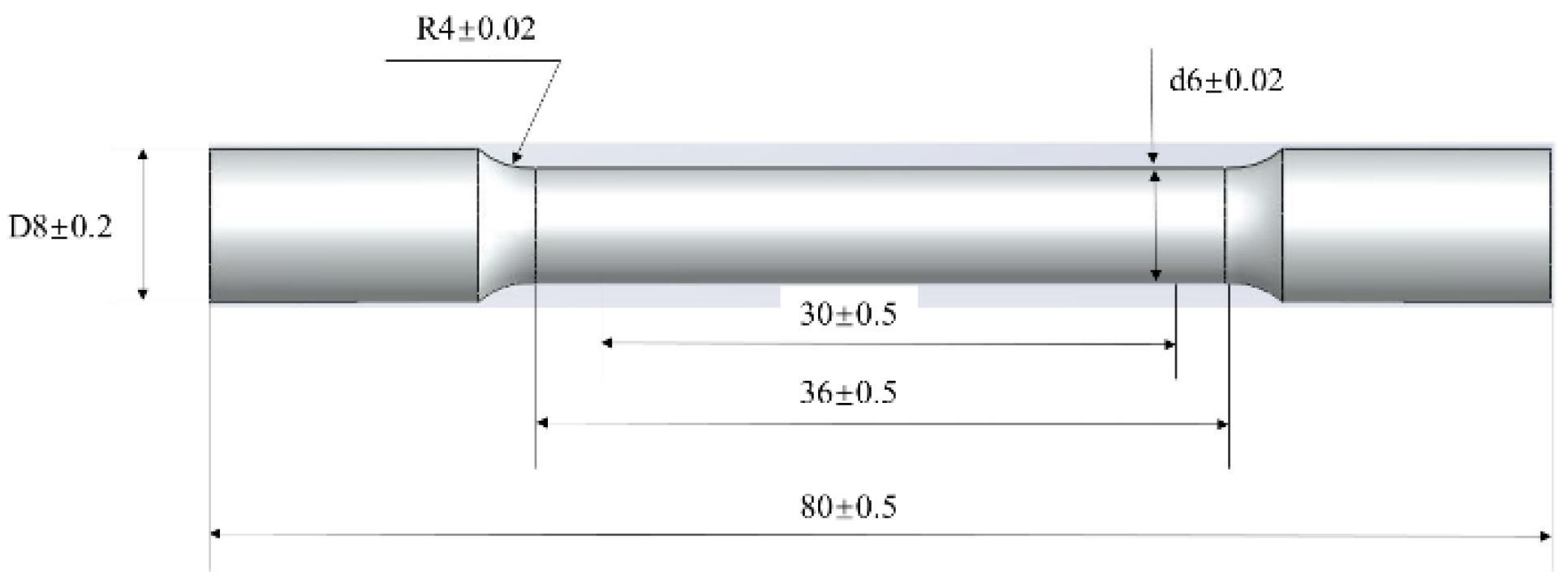
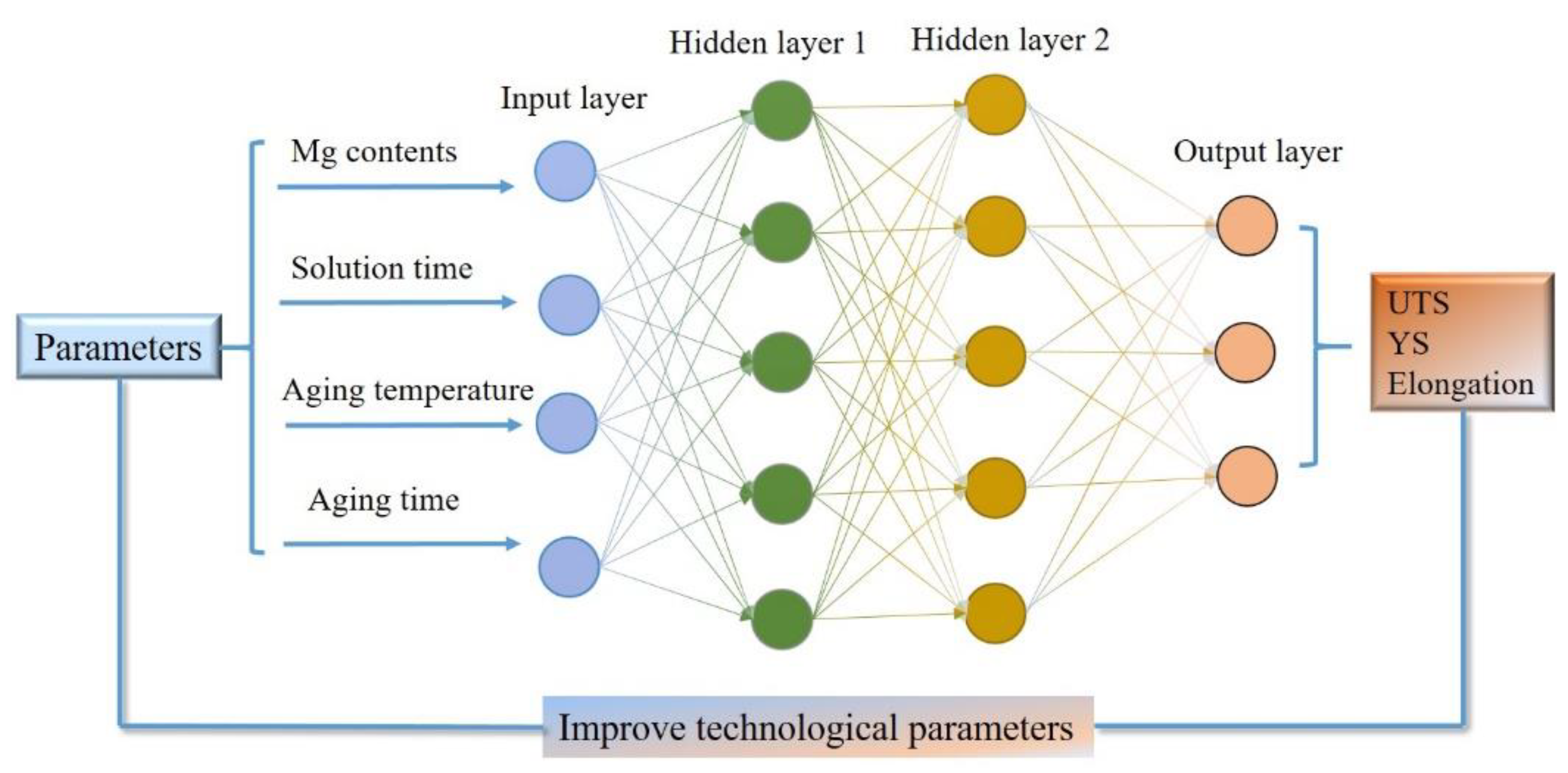

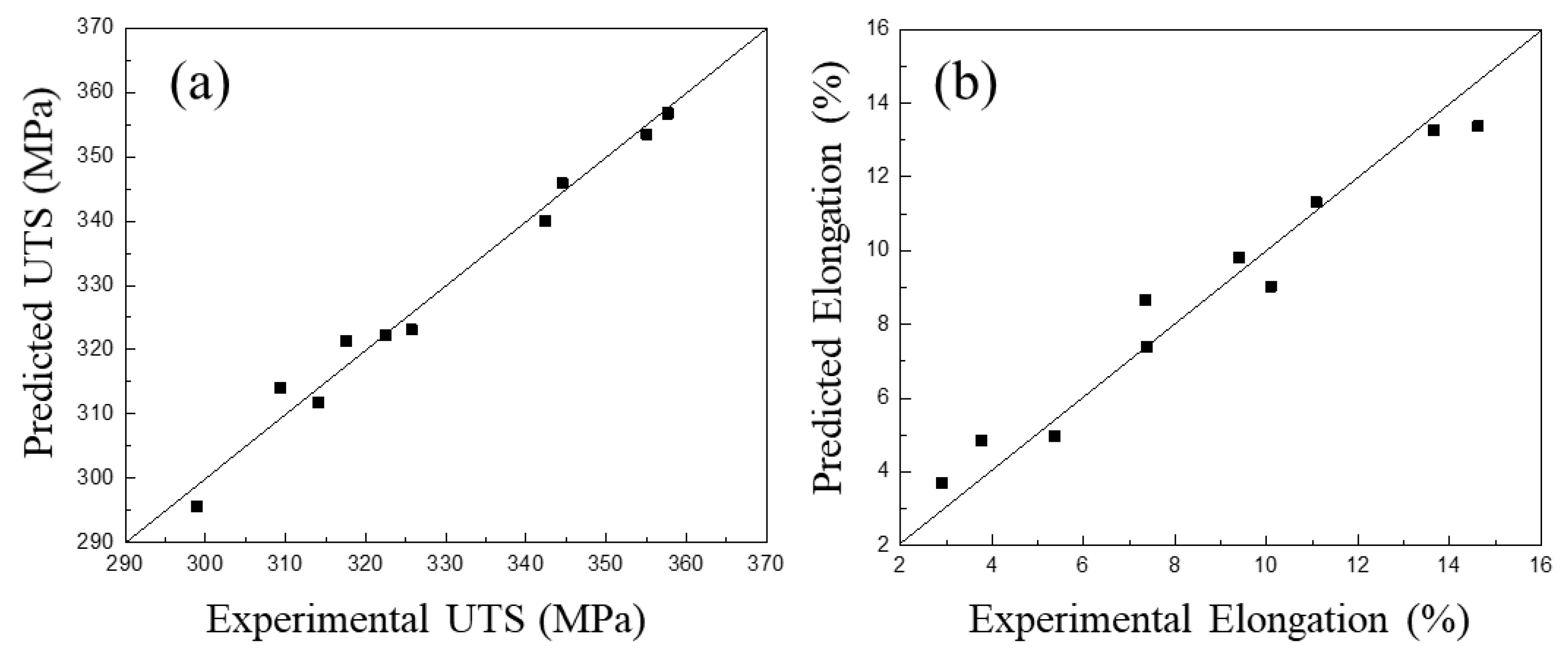

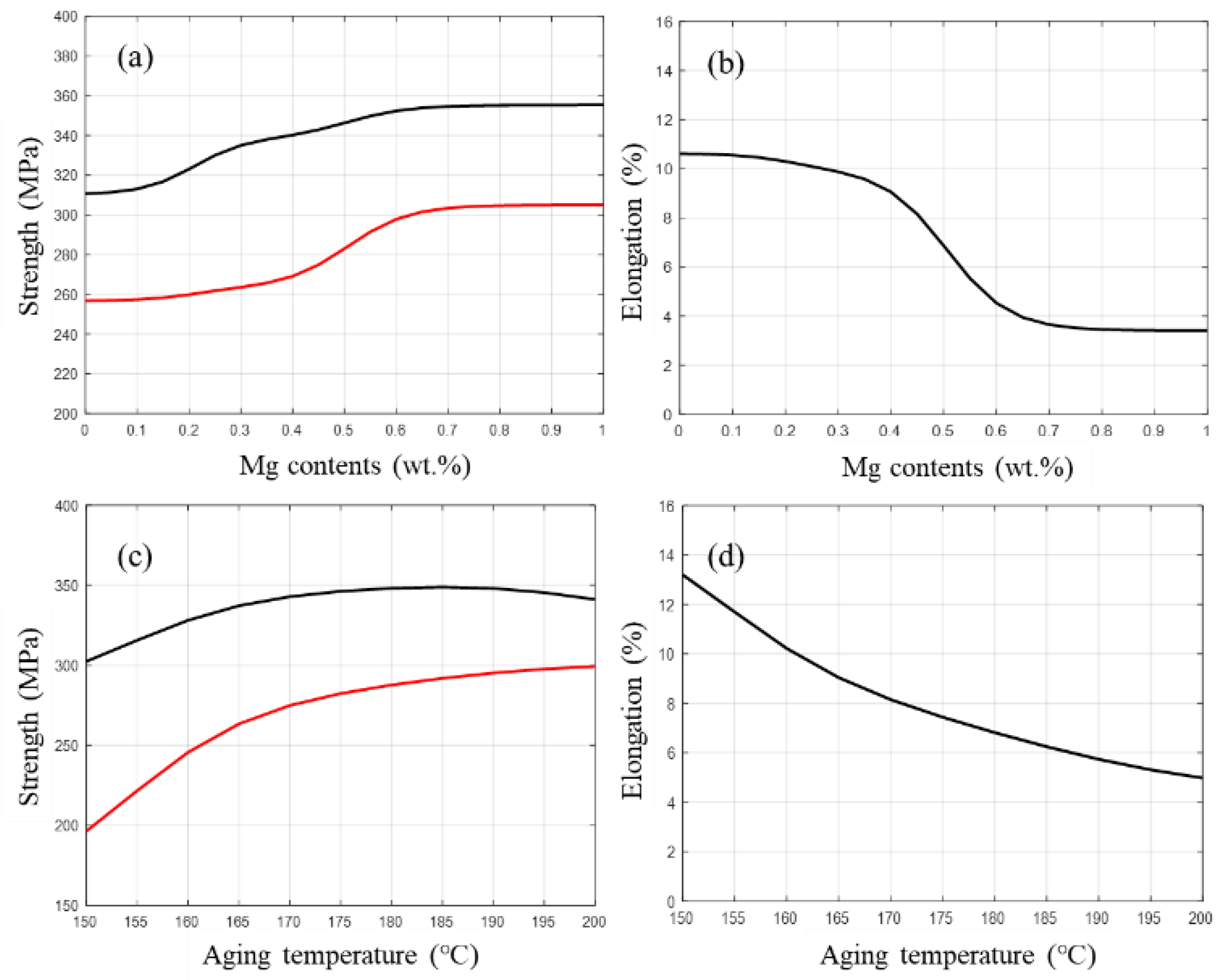
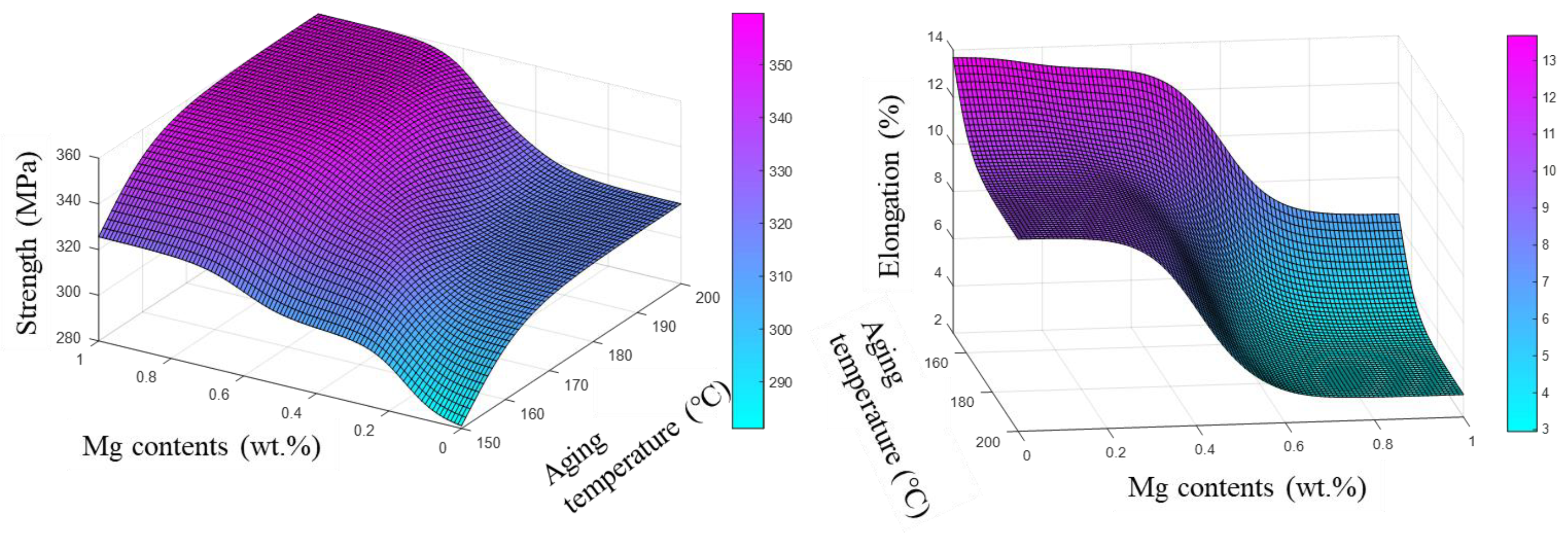
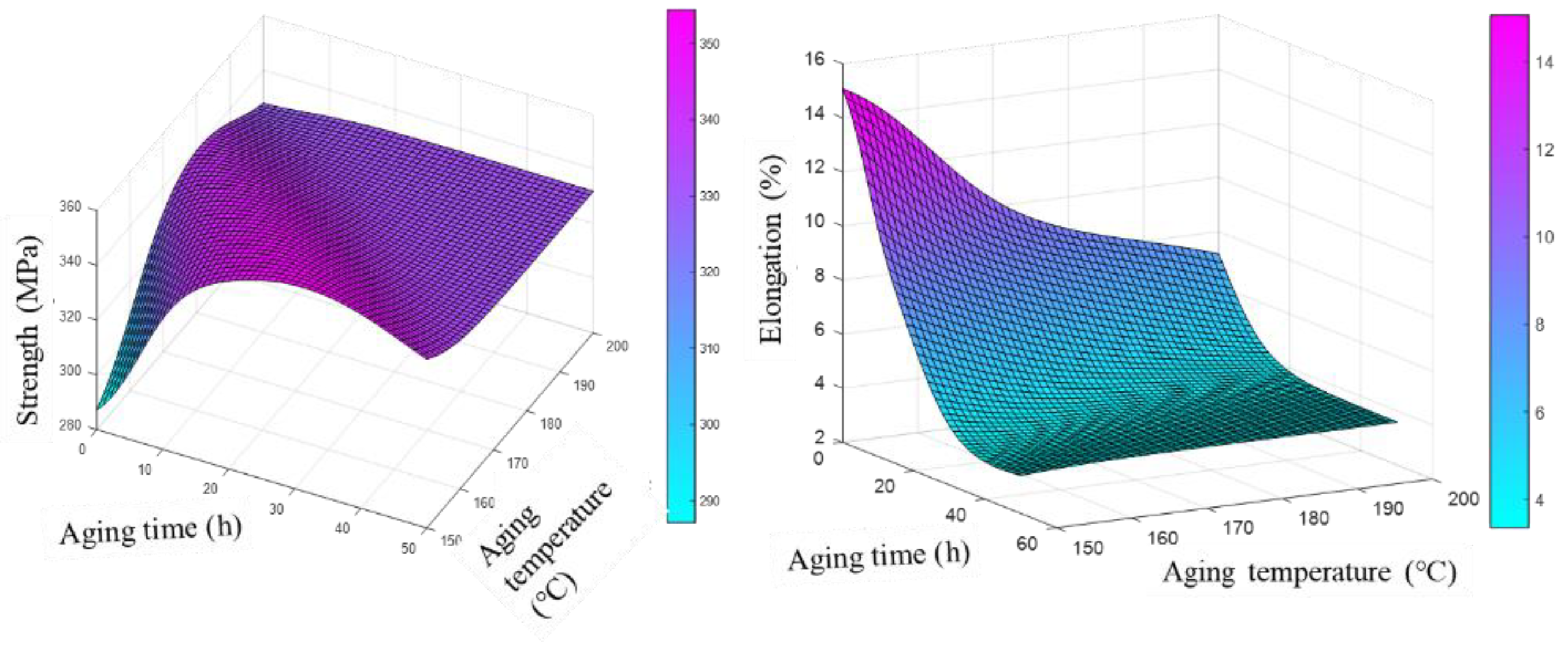
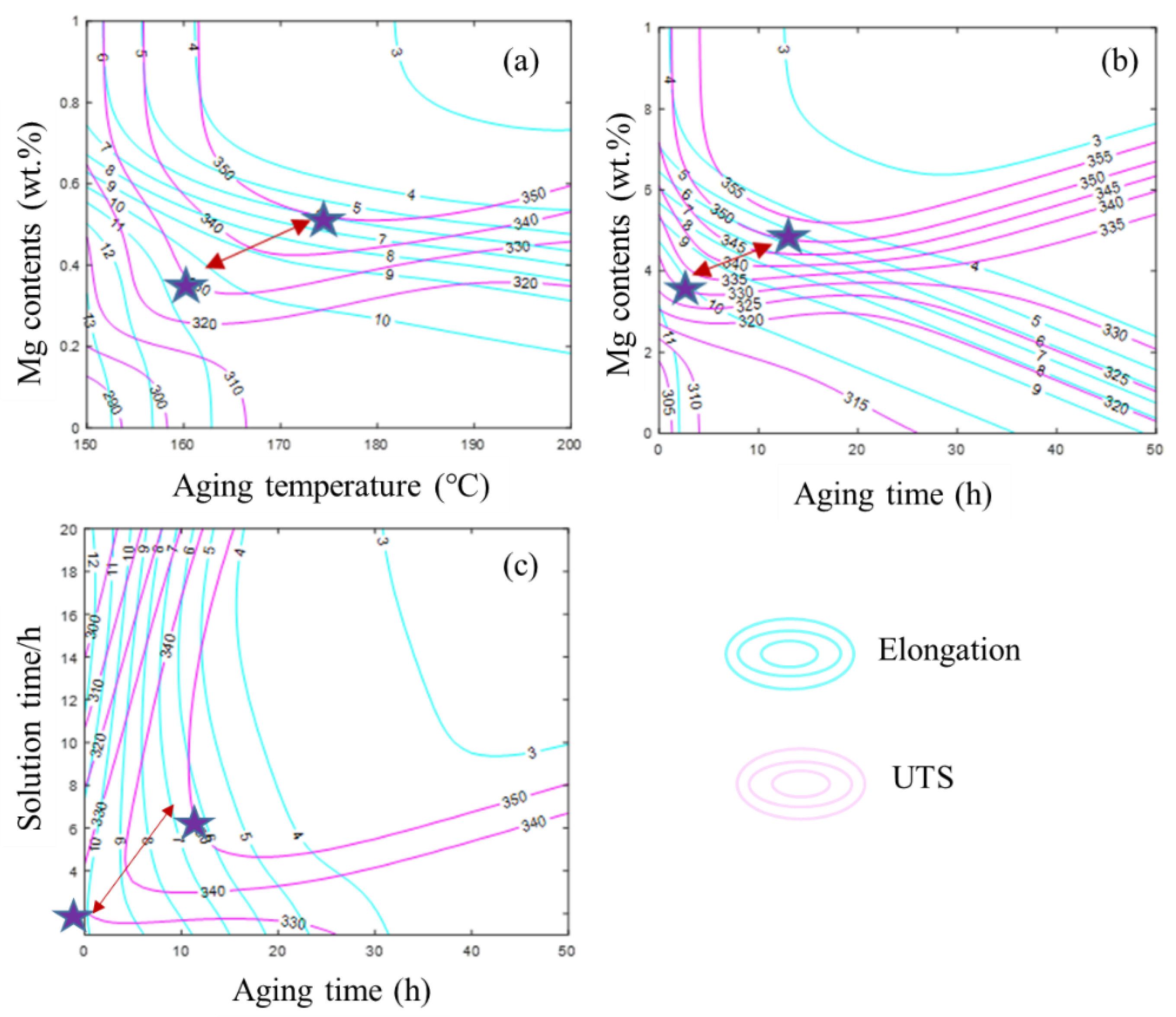

| Alloys | Si | Mg | Fe | Cu | Ti | Sr | Al |
|---|---|---|---|---|---|---|---|
| Al–7Si–0.3Mg | 7.134 | 0.301 | 0.115 | 0.072 | 0.144 | 0.015 | Balance |
| Al–7Si–0.45Mg | 7.123 | 0.455 | 0.122 | 0.079 | 0.148 | 0.015 | Balance |
| Al–7Si–0.6Mg | 6.978 | 0.608 | 0.111 | 0.075 | 0.15 | 0.015 | Balance |
| Experimental Data | Input and Output Variables | Minimum | Maximum |
|---|---|---|---|
| 65 training + 7 test data sets | Mg contents (wt.%) | 0.3 | 0.6 |
| Solution time (h) | 2 | 8 | |
| Aging temperature (°C) | 150 | 190 | |
| Aging time (h) | 1 | 42 | |
| Ultimate tensile strength (MPa) | 263.34 | 359.27 | |
| Yield strength (MPa) | 130.85 | 324.33 | |
| Elongation (%) | 1.07 | 18.19 |
| The number of layers | Input layers: 1, hidden layers: 2, output layers: 1 |
| The number of neurons on the layers | Input neurons: 4, hidden neurons: 10 + 11, output neurons: 3 |
| The initial weights and biases | Randomly between −1 and 1 |
| The learning algorithm | Traindm |
| The learning rate | 0.01 |
| Activation function | purelin; purelin; tansig |
| Number of iterations | 1000 |
| Acceptable mean-squared error | 0.001 |
| The number of samples | 72 |
| 1 | 2 | 3 | 4 | 5 | 6 | 7 | 8 | 9 | 10 | 11 | |
|---|---|---|---|---|---|---|---|---|---|---|---|
| U | −0.4023 | 0.5292 | −0.101 | −0.0045 | 0.2112 | 0.5448 | 0.7152 | −0.3718 | −0.2403 | 0.6613 | 0.8859 |
| Y | −0.6832 | 0.3263 | −0.2466 | 0.5169 | −0.5475 | −0.3655 | −0.3598 | −0.6839 | −0.2836 | −0.2466 | −0.4508 |
| L | −0.2647 | −0.0014 | 0.5874 | 0.2985 | −0.2851 | 0.5568 | 0.3655 | 0.754 | −0.4439 | 0.6605 | −0.3456 |
| a | b | c | d | e | f | g | h | i | j | m | |
|---|---|---|---|---|---|---|---|---|---|---|---|
| 1 | 0.1355 | 0.1255 | −0.9365 | 0.9695 | 0.6344 | 0.9022 | 0.6263 | −0.2795 | −0.1363 | −0.1189 | 0.1248 |
| 2 | 0.0744 | 0.82 | 0.7178 | 0.8577 | −0.6858 | −0.0634 | 0.1839 | 0.4274 | 0.0599 | 0.9389 | 0.3639 |
| 3 | 0.2032 | 0.5231 | −0.132 | 0.54 | 0.3878 | 0.291 | 0.7298 | 0.5249 | −0.3397 | −0.067 | 0.8802 |
| 4 | 0.7328 | 0.5411 | −0.9638 | −0.8818 | 0.6809 | −0.3138 | 0.9492 | −0.498 | 0.3938 | −0.8847 | 0.2863 |
| 5 | 0.3375 | 0.5537 | −0.4681 | 0.2553 | 0.784 | 0.0925 | −0.8659 | 0.0174 | 0.914 | −0.7707 | 0.0188 |
| 6 | 0.9318 | −0.3483 | 0.1548 | −0.1213 | −0.8568 | −0.0474 | −0.1418 | −0.4778 | 0.3957 | −0.5603 | 0.5742 |
| 7 | −0.2923 | −0.8708 | 0.9148 | 0.0767 | 0.2453 | 0.4271 | 0.1244 | −0.9487 | 0.6576 | 0.5976 | 0.9884 |
| 8 | 0.3035 | 0.8515 | −0.9912 | −0.3685 | −0.0279 | 0.9527 | 0.5688 | 0.738 | 0.8249 | −0.5653 | 0.9095 |
| 9 | 0.1694 | −0.8473 | 0.6527 | −0.0688 | −0.4011 | 0.8883 | 0.0669 | 0.2996 | 0.728 | 0.8003 | 0.6363 |
| 10 | −0.1005 | −0.5128 | 0.9207 | 0.0134 | −0.8876 | −0.3215 | 0.4775 | 0.7924 | −0.819 | −0.1909 | 0.4992 |
| 11 | −0.5446 | −0.3827 | 0.4031 | −0.6027 | −0.3251 | −0.5347 | 0.9466 | 0.8724 | 0.5415 | 0.0567 | 0.9977 |
| α | β | γ | δ | f | |
|---|---|---|---|---|---|
| 1 | 0.1702 | 0.107 | −0.7954 | −0.8409 | −0.5536 |
| 2 | 0.0846 | 0.8242 | 0.6174 | 0.0262 | 0.9687 |
| 3 | −0.2316 | 0.8773 | 0.1259 | −1.0369 | −0.4795 |
| 4 | −0.8426 | 0.2355 | 0.1741 | 0.5634 | 0.8002 |
| 5 | −0.8532 | 0.8353 | 1.0346 | 0.3406 | 0.9818 |
| 6 | 0.4669 | −0.3255 | −0.5395 | −0.6221 | −0.4456 |
| 7 | 0.5046 | 0.8691 | −0.9924 | −0.3892 | −0.0743 |
| 8 | −0.6015 | −0.0607 | 0.4271 | −0.5255 | −0.5005 |
| 9 | −0.9256 | −0.0907 | 0.2325 | −0.5866 | −0.2625 |
| 10 | 0.3276 | −0.8509 | −0.6511 | −0.0639 | −1.0178 |
| Designed Mechanical Properties | Mg Content/wt.% | Solution Time/h | Aging Temperature/°C | Aging Time/h | |||
|---|---|---|---|---|---|---|---|
| UTS/MPa | YS/MPa | E/% | |||||
| A | 315.8 | 237.2 | 13.5 | 0.27 | 3.85 | 164 | 2.2 |
| B | 340.4 | 289.3 | 8.5 | 0.45 | 4.2 | 168 | 17.5 |
| C | 356.8 | 317.5 | 5.1 | 0.65 | 3.3 | 173 | 12.8 |
© 2019 by the authors. Licensee MDPI, Basel, Switzerland. This article is an open access article distributed under the terms and conditions of the Creative Commons Attribution (CC BY) license (http://creativecommons.org/licenses/by/4.0/).
Share and Cite
Wu, X.; Zhang, H.; Cui, H.; Ma, Z.; Song, W.; Yang, W.; Jia, L.; Zhang, H. Quantitative Relationship Analysis of Mechanical Properties with Mg Content and Heat Treatment Parameters in Al–7Si Alloys Using Artificial Neural Network. Materials 2019, 12, 718. https://doi.org/10.3390/ma12050718
Wu X, Zhang H, Cui H, Ma Z, Song W, Yang W, Jia L, Zhang H. Quantitative Relationship Analysis of Mechanical Properties with Mg Content and Heat Treatment Parameters in Al–7Si Alloys Using Artificial Neural Network. Materials. 2019; 12(5):718. https://doi.org/10.3390/ma12050718
Chicago/Turabian StyleWu, Xiaoyan, Huarui Zhang, Haiyang Cui, Zhen Ma, Wei Song, Weimin Yang, Lina Jia, and Hu Zhang. 2019. "Quantitative Relationship Analysis of Mechanical Properties with Mg Content and Heat Treatment Parameters in Al–7Si Alloys Using Artificial Neural Network" Materials 12, no. 5: 718. https://doi.org/10.3390/ma12050718
APA StyleWu, X., Zhang, H., Cui, H., Ma, Z., Song, W., Yang, W., Jia, L., & Zhang, H. (2019). Quantitative Relationship Analysis of Mechanical Properties with Mg Content and Heat Treatment Parameters in Al–7Si Alloys Using Artificial Neural Network. Materials, 12(5), 718. https://doi.org/10.3390/ma12050718







